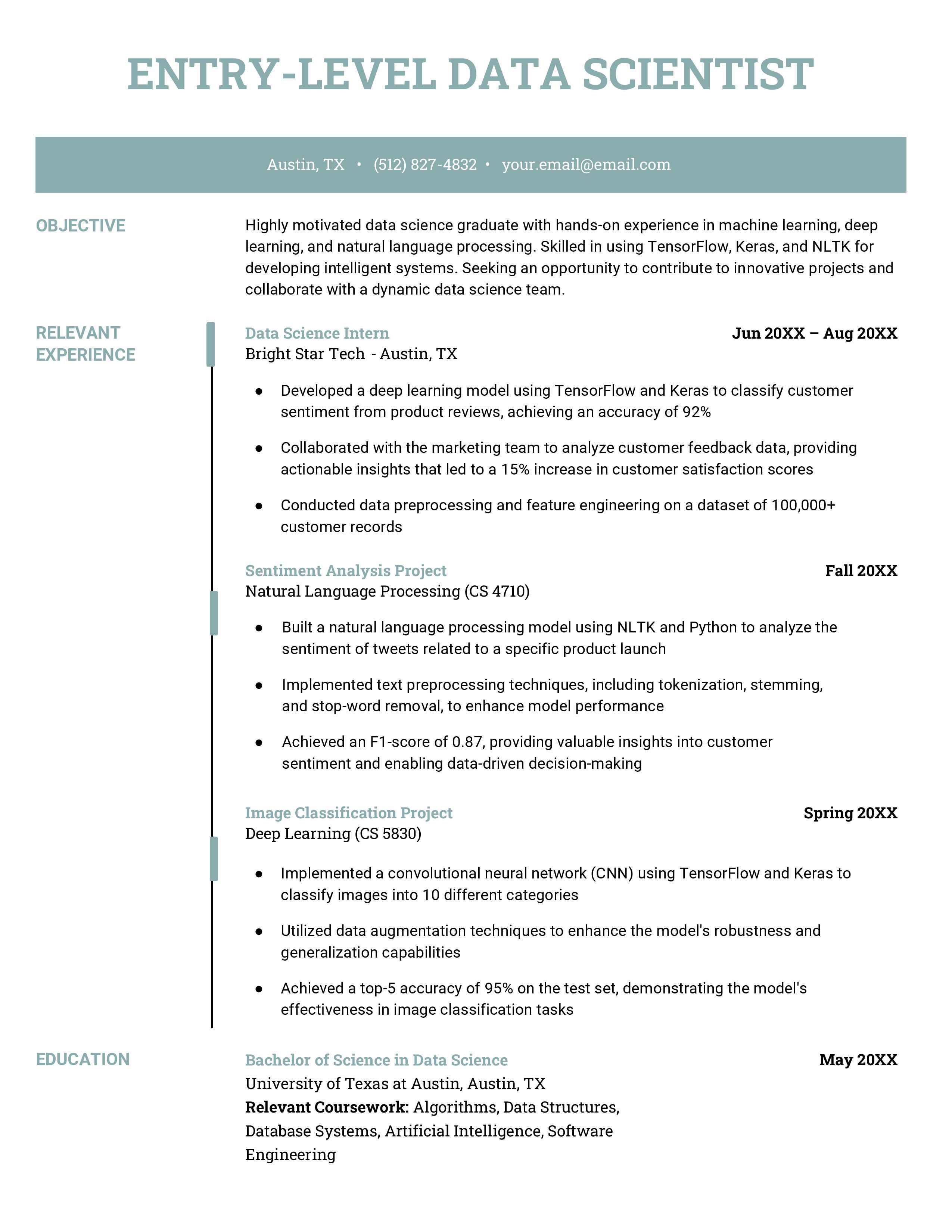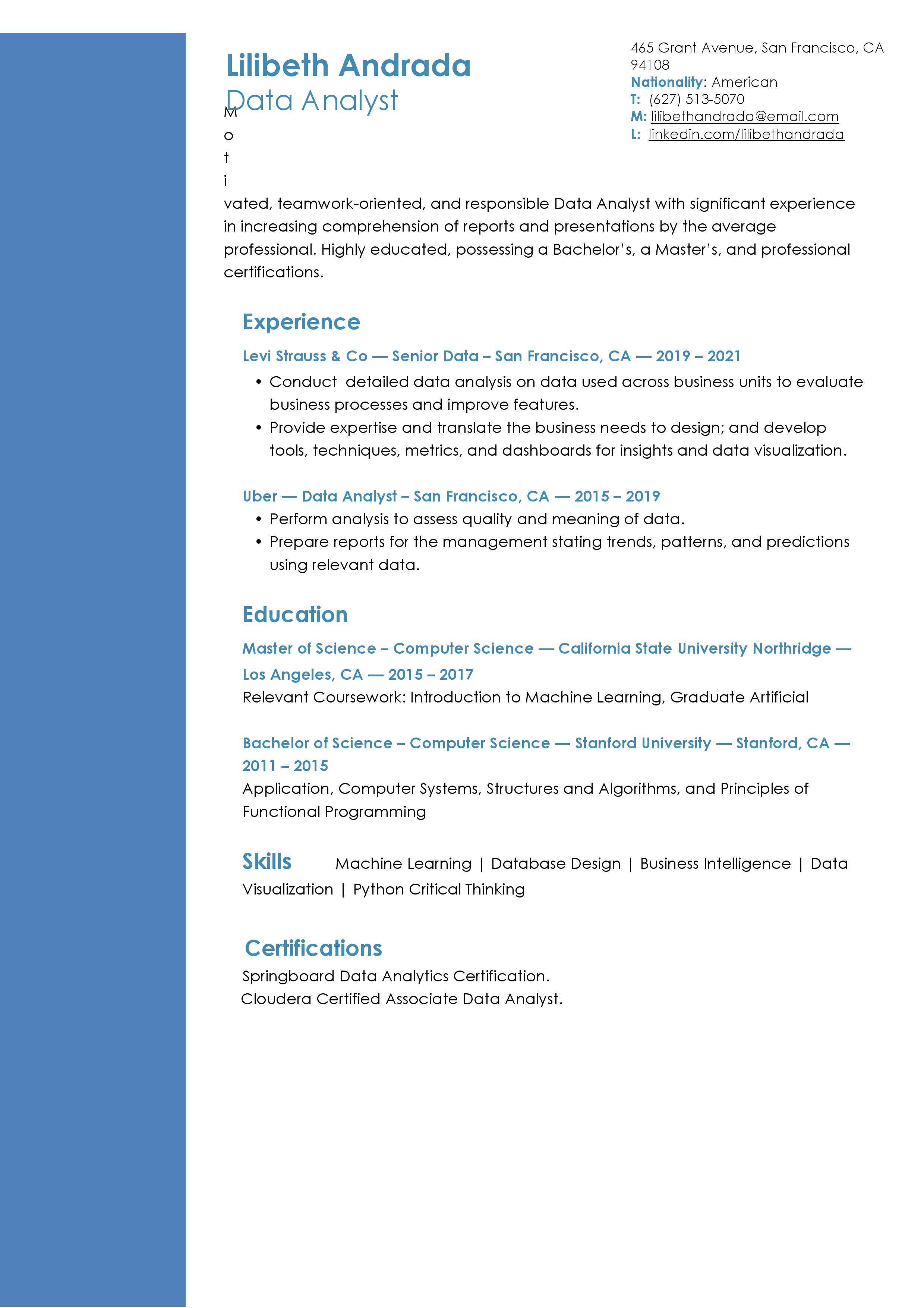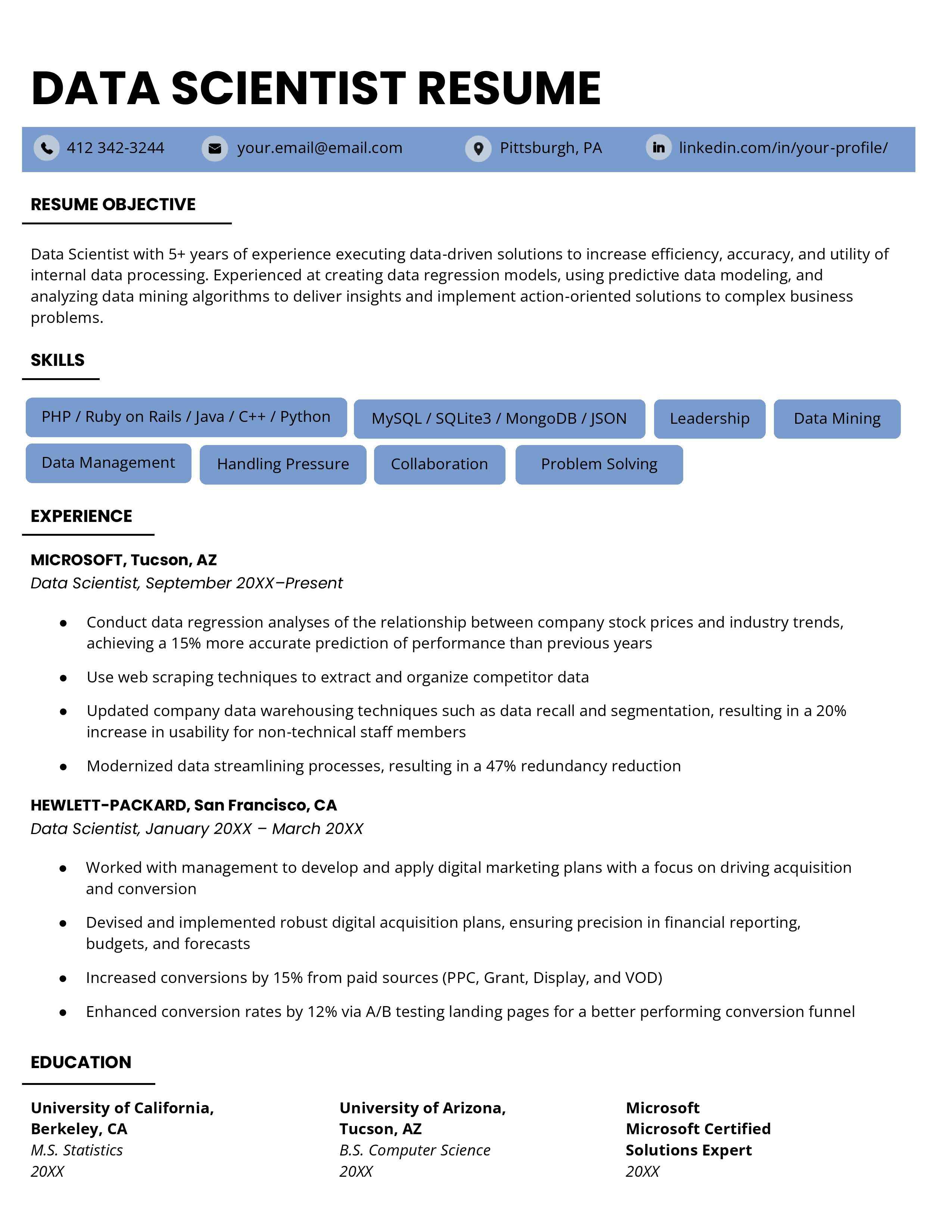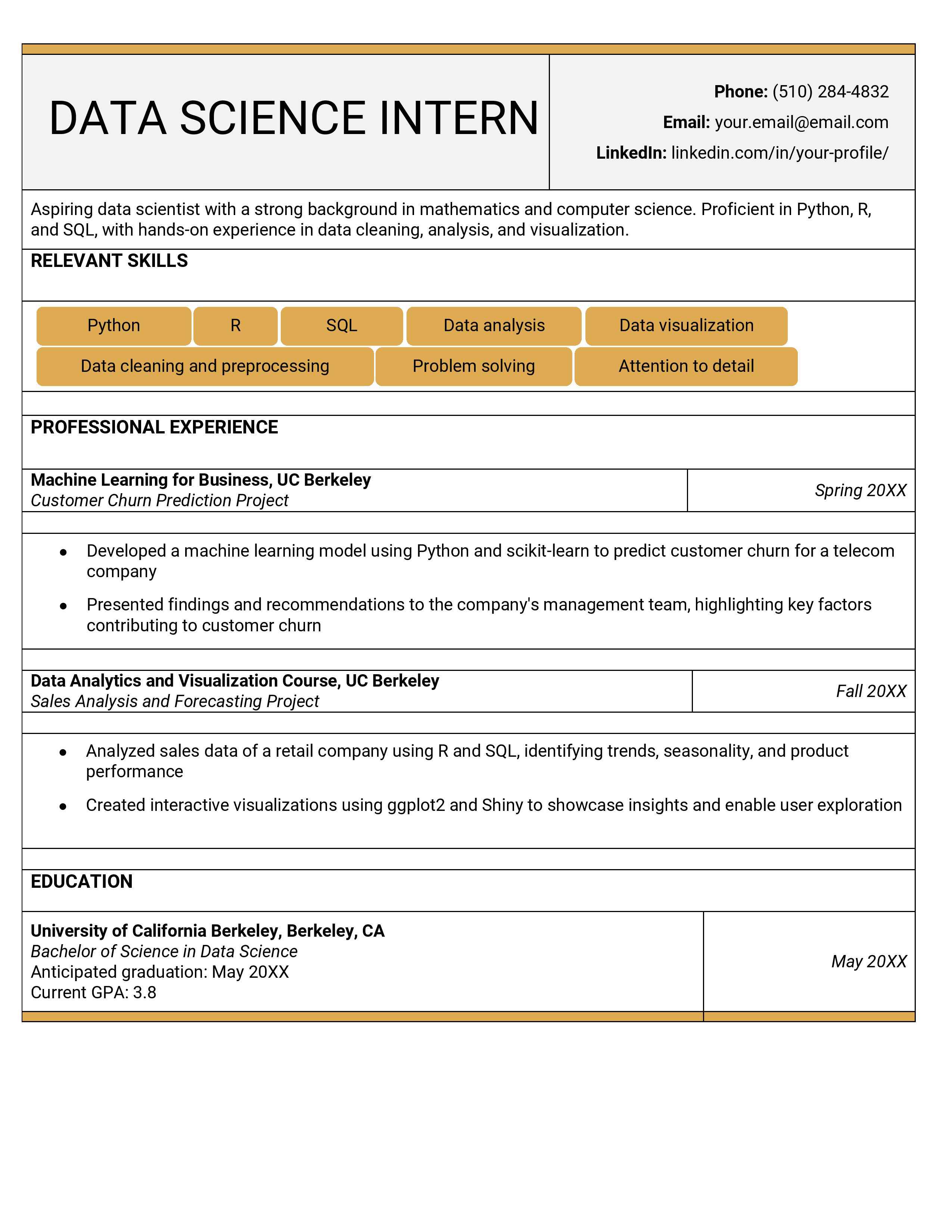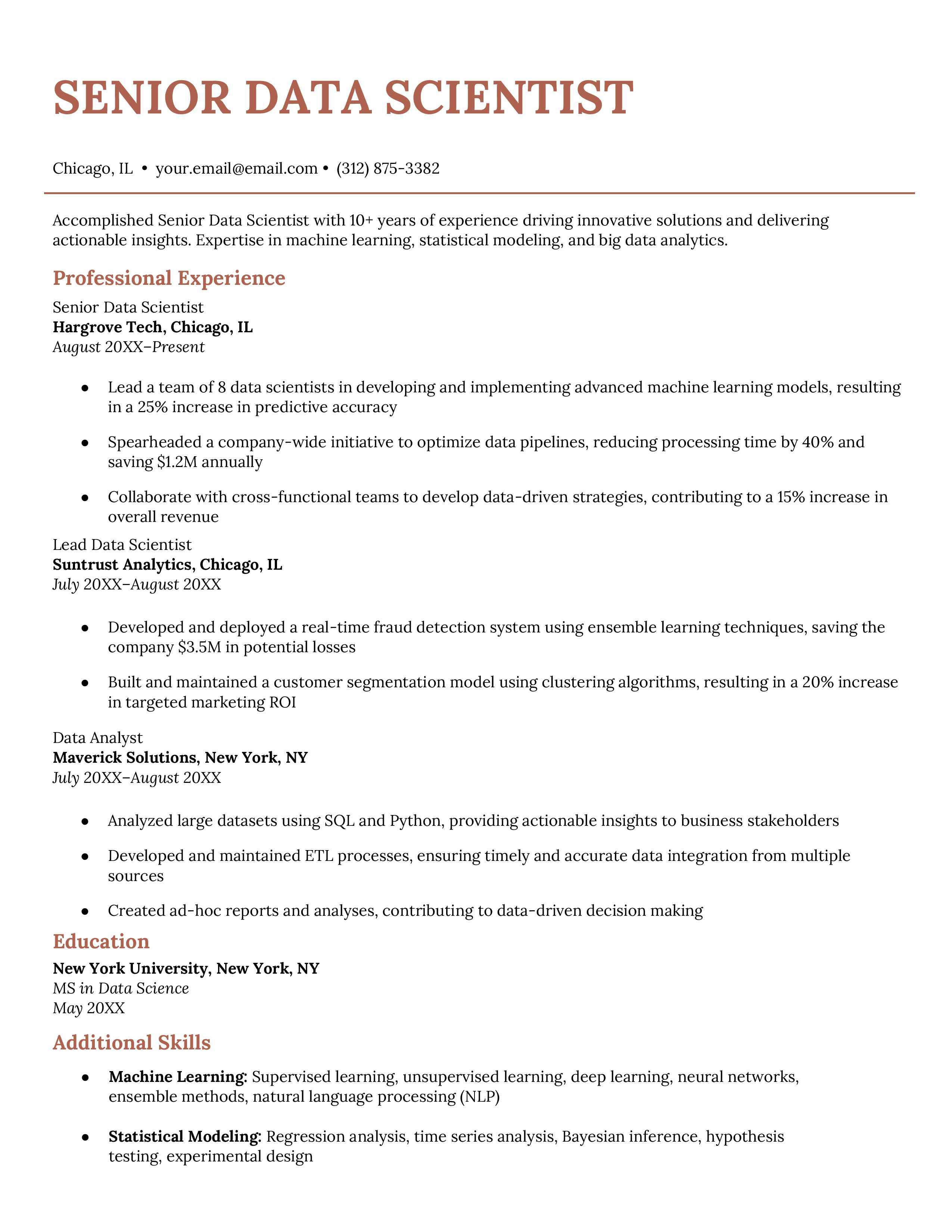Data Scientist Resume
Published on September 7th, 2024
A well-crafted Data Scientist resume is essential to landing a top-tier role in one of the most in-demand fields today. As a data scientist, you're expected to analyze complex data sets, extract meaningful insights, and provide data-driven solutions to business challenges. Your resume should reflect your ability to handle large data sets, apply machine learning techniques, and communicate results effectively.
This guide will provide a comprehensive breakdown of how to structure your Data Scientist resume and highlight your technical skills, experience, and achievements.
Key Roles and Responsibilities of a Data Scientist
When creating a Data Scientist resume, it’s important to emphasize key responsibilities that align with the job description you're applying for. Some of the most common responsibilities for a data scientist include:
- Data Collection and Processing: Gathering, cleaning, and preparing large datasets for analysis.
- Statistical Analysis: Applying statistical models to analyze data trends and patterns.
- Machine Learning: Building and deploying machine learning models to solve complex business problems.
- Data Visualization: Creating clear and understandable visualizations to present findings to non-technical stakeholders.
- Programming: Proficiency in programming languages such as Python, R, SQL, and other data-focused languages.
- Business Intelligence: Working with departments across the organization to identify key metrics and create actionable insights.
- Model Deployment and Maintenance: Continuously improving models and ensuring their integration into production systems.

Data Scientist Resume Templates
When designing a Data Scientist resume, it’s important to use a clean, structured format that emphasizes both technical and soft skills. Some essential sections to include are:
Template 1
To find more Data Scientist Resume, check out our free Resume Templates.
Data Scientist Resume Tips
To create a winning resume, there are several important tips you should follow:
- Tailor to Job Description: Review the job description and adjust your resume to include keywords and relevant skills that align with the position.
- Quantify Achievements: Whenever possible, quantify your accomplishments. For example, "Improved algorithm performance by 20% by optimizing data pipelines" or "Reduced data processing time by 50% through model optimization."
- Highlight Your Technical Skills: Data Science requires a unique combination of technical and analytical skills. Include key skills such as:
- Python, R, SQL, Hadoop, Spark, TensorFlow
- Statistical Modeling and Machine Learning Algorithms
- Data Wrangling and Cleaning
- Data Visualization (Tableau, PowerBI, Matplotlib, Seaborn)
- Include Relevant Projects: Data science is a project-driven field, and hiring managers want to see tangible examples of your work. Include personal or professional projects where you’ve built models, analyzed datasets, or applied machine learning techniques.
- Use Action Verbs: Start each bullet point in your professional experience section with action verbs like "Developed," "Implemented," "Analyzed," or "Optimized."
- Focus on Business Impact: While technical skills are essential, make sure to highlight how your work impacted the business or organization. For example, "Increased revenue by 15% through predictive modeling of customer purchasing behavior."
Writing Your Data Scientist Resume: Section by Section
- Contact Information: At the top of your resume, list your full name, phone number, email address, and LinkedIn profile or personal portfolio (if applicable).
- Professional Summary: Write a concise, 2-3 sentence summary that encapsulates your experience, technical skills, and professional achievements. For example: "Results-driven Data Scientist with 5+ years of experience in applying machine learning techniques, statistical analysis, and data visualization to solve business problems. Proven track record in developing predictive models that optimize business outcomes and deliver actionable insights."
- Core Competencies / Skills: This section should be a bulleted list of the most relevant technical and analytical skills, such as:
- Machine Learning Algorithms (Supervised and Unsupervised Learning)
- Data Wrangling and Cleaning
- Statistical Modeling and Hypothesis Testing
- Programming Languages (Python, R, SQL)
- Data Visualization (Tableau, Matplotlib, Seaborn)
- Cloud Computing (AWS, Azure, Google Cloud)
- Big Data Tools (Hadoop, Spark)
- Professional Experience: In reverse chronological order, list your previous job roles. Under each role, use bullet points to describe your contributions and achievements using quantifiable results when possible.
Example: Senior Data Scientist – XYZ Analytics
June 2019 – Present- Developed predictive models using Python and R, increasing the accuracy of demand forecasting by 30%.
- Collaborated with the marketing team to analyze customer data and provide insights that increased retention rates by 15%.
- Implemented a machine learning pipeline to automate data cleaning, reducing data processing time by 40%.
- Projects: If you have relevant projects outside of your professional experience, list them in a separate section. Include project names, a brief description, and key outcomes.
Example:
Project: Customer Churn Prediction Model- Built a machine learning model using random forests to predict customer churn with 85% accuracy, enabling proactive customer retention strategies.
- Education: Include your academic background, including your degree(s), university name, and graduation year. List any relevant coursework or honors if applicable.
- Certifications: Data scientists often hold certifications in specialized areas. Include certifications such as:
- Google Professional Data Engineer
- Microsoft Certified: Azure Data Scientist Associate
- Coursera Machine Learning (Andrew Ng)
- IBM Data Science Professional Certificate
- Publications / Awards (Optional): If you've published papers, contributed to open-source projects, or won any awards related to data science, consider listing them in a separate section.
Conclusion
Creating an effective Data Scientist resume involves showcasing not only your technical expertise but also your ability to drive business outcomes. Focus on quantifiable achievements, and tailor your resume to the job you’re applying for by emphasizing relevant skills, projects, and experience.
With data science becoming more competitive, your resume should clearly demonstrate your ability to work with complex data, apply machine learning algorithms, and communicate results effectively to stakeholders. By following this guide, you’ll create a resume that grabs attention and maximizes your chances of landing your next Data Scientist role.
Authors

Soujanya Varada
As a technical content writer and social media strategist, Soujanya develops and manages strategies at HireQuotient. With strong technical background and years of experience in content management, she looks for opportunities to flourish in the digital space. Soujanya is also a dance fanatic and believes in spreading light!
Hire the best without stress
Ask us how
Never Miss The Updates
We cover all recruitment, talent analytics, L&D, DEI, pre-employment, candidate screening, and hiring tools. Join our force & subscribe now!
Stay On Top Of Everything In HR

